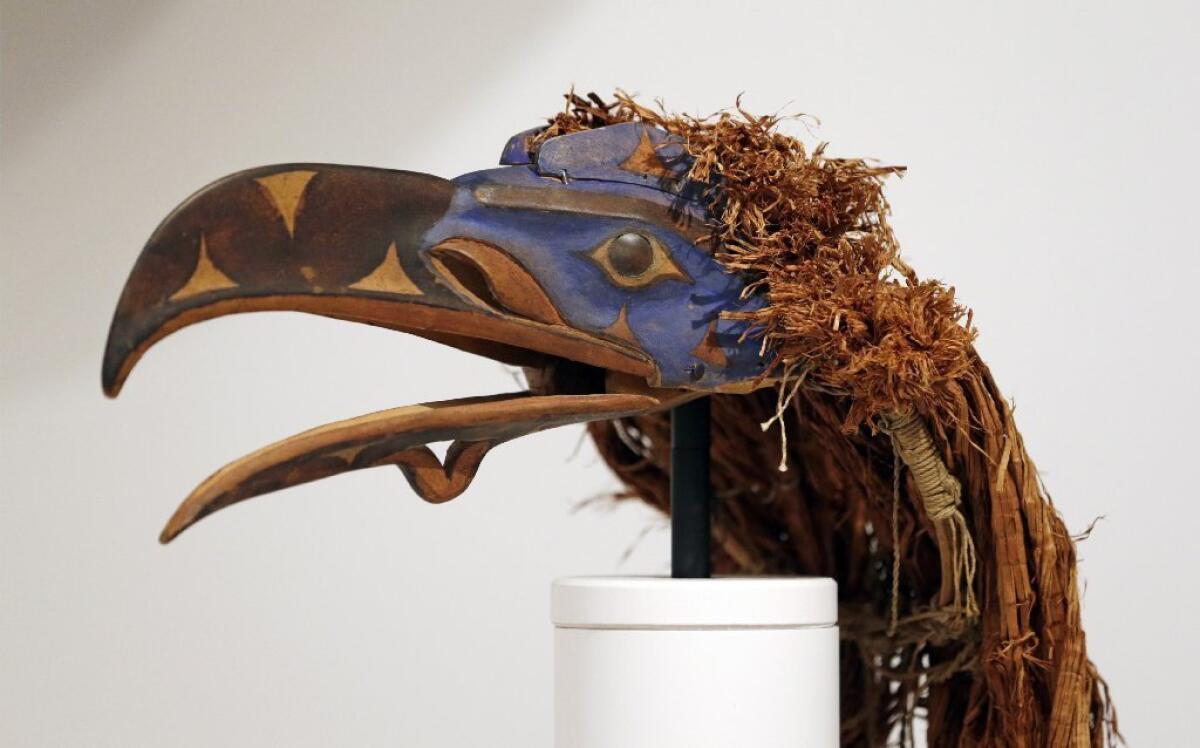Museum’s Super Bowl bet shows pitfalls that come with Native art

Museums risk consequences if they treat native peoples’ spiritual objects simply as regular artworks, as the Seattle Art Museum learned this week when it briefly wagered a ceremonial tribal mask from British Columbia in a playful bet with the Denver Art Museum on Sunday’s Super Bowl.
The two museums announced early this week that a 135-year-old Nuxalk mask would be sent from Seattle to Denver as a three-month loan if the Denver Broncos won the game, and “The Broncho Buster,” an 1895 bronze statue by Frederic Remington, would head in the opposite direction should the Seattle Seahawks prevail.
But the Nuxalk Nation, based in Bella Coola, Canada, objected, and the Seattle museum quickly removed the raven’s head mask from the bet. It substituted a large 1901 screen drawing of an eagle by Japanese artist Tsuji Kako as its stake in the bet.
ART: Can you guess the high price?
Charles Nelson, hereditary leader of one of the Nuxalk Nation’s 18 families, said Seattle Art Museum director Kimerly Rorschach apologized by telephone on Wednesday and has agreed to bring the mask to Bella Coola and make a public apology.
“What happened was upsetting for sure,” he said Wednesday, not just because the tribe considered the mask, which has spiritual significance, inappropriate for a lighthearted bet, but because the museum didn’t consult with the Nuxalk Nation before making it.
“We accepted the apology,” Nelson said, and the Nuxalk look forward to talking further with museum leaders about the implications of harboring sacred objects in their collections.
Nelson said the Nuxalk Nation aims to explore whether the Seattle Art Museum would be willing to repatriate the mask, or at least make it available for ceremonial use.
Seattle Art Museum spokeswoman Wendy Malloy confirmed that Rorschach had apologized by phone and plans to bring the mask to the Bella Coola for a public apology.
The two museums’ original news release about their bet described the Seattle wager as “a majestic Native American mask reminiscent of a mighty ‘Seahawk’” whose “open mouth suggests the ferocity of this bird of prey, possibly a supernatural ‘man-eater’” used in “dance-dramas.”
GRAPHIC: Highest-earning art executives
The Seattle Art Museum’s online collection catalog is more circumspect, identifying the mask as an image of Raven, a spirit with “many ... manifestations” including “culture hero, trickster or supernatural being associated with family songs and dances.”
Nelson said the painted raven, crafted mainly from alder wood and red cedar bark, is a Sisawq Society mask, worn by hereditary Nuxalk leaders in ceremonies such as weddings and the naming of newborns.
The presence of Nuxalk ceremonial objects in museum collections “stirs up mixed feelings with our people,” he said. “Museums in general are working hard to create better relations with indigenous peoples, and we want to learn from them.”
The Nuxalk Nation’s history includes forced relocation, education imposed by outsiders, and a decimation of the population from thousands to a few hundred, Nelson said, adding that he wondered whether the Seattle museum’s mask left Nuxalk hands legitimately, or was stolen or taken by force.
The Seattle Art Museum’s online catalog says it received the raven mask as a gift in 1991 -- one of seven Nuxalk masks donated by a single Seattle resident in 1985 and 1991. The donor is said to have acquired the other masks in the 1960s and 1970s, but no dates are given for the one the museum had briefly wagered on the Super Bowl.
CRITICS’ PICKS: What to watch, where to go, what to eat
“It’s both saddening and a blessing that they’re in a museum,” Nelson said. “It’s saddening that we don’t have them here. The blessing is they’re still there, they were not destroyed. That’s why we want the relationship [with the museum] to continue, so we can look at things” such as restoring them to the Nuxalk Nation or making them available for its ceremonies.
Last year, two auctions of Native American artifacts in Paris stirred raw emotions and went forward despite tribes’ objections.
“This is not merchandise, these are sacred beings!” one woman shouted as the gavel came down on a Hopi “Mother Crow” mask last April. A December auction brought a different outcome when the Los Angeles-based Annenberg Foundation successfully bid $530,000 for 21 Hopi masks and three San Carlos Apache headdresses so they could be restored to the tribes.
When L.A.’s Autry National Center of the American West mounted “Katsina in Hopi Life,” a 2012-13 exhibition of the tribe’s symbolic dolls and figurines, it hired two Hopi tribe members as the show’s curators.
In an interview last year while the exhibition was still running, Autry President W. Richard West Jr., a member of the Cheyenne tribe and founding director of the Smithsonian Institution’s National Museum of the American Indian, said that “consulting with native communities” becomes imperative for museums when dealing with how to use or display their native artifacts.
In the case of the Hopi exhibition, he said, the curators helped the Autry identify which collection items were suitable for display, and which would be considered too sacred to be shown publicly.
Under the Native American Graves Protection and Repatriation Act, passed by Congress in 1990, museums and other institutions that receive federal funding are obligated to repatriate skeletons and other human remains in their collections to the tribe of origin. But the process has been painfully slow because of bureaucratic hurdles and difficulties in identifying where the remains came from.
ALSO:
UC and Native Americans: unsettled remains
A bid to restore spiritual artifacts to Hopi and Apache tribes
Hopi masks auctioned in Paris amid outrage and legal objections
More to Read
The biggest entertainment stories
Get our big stories about Hollywood, film, television, music, arts, culture and more right in your inbox as soon as they publish.
You may occasionally receive promotional content from the Los Angeles Times.











